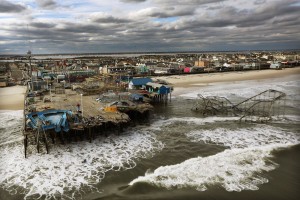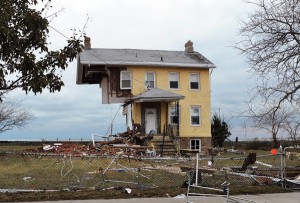Two years ago the Jersey Shore, a place where I call home, was devastated by Hurricane Sandy. My friends and family were left without heat, electricity, and some were left without homes. While my family was fortunate enough to have mild damages to our properties, others had lost everything. The first time I returned home, about a month after Sandy, there were still incredible signs of the destruction. Boats were still washed up on major roads, the streets were still full of debris, and beach towns resembled ghost towns. I observed places that were once very familiar seem almost unrecognizable.
This famous photograph (above) was taken in a nearby town, which I recalled having to pull a u-turn in the driveway during the previous summer months. Hurricane Sandy forever altered the landscapes of the Jersey Shore.
During our trip to Washington DC, we spoke with Joel Scheraga, the Senior Advisor for Climate Adaptation in the Office of Policy in the Office of the Administrator at the U.S. Environmental Protection Agency. Joel Scheraga spoke to us about the importance of mainstreaming climate adaptation planning. As we have already seen impacts of climate change through intensifying natural disasters like Hurricane Sandy, it is imperative that the process of redevelopment incorporates climate-resilient methods. It is the EPA’s mission to anticipate and plan for future changes in climate. Climate adaptation will prepare the world for the impacts of climate change.
After meeting with Joel Scheraga, I began to wonder in what ways the Jersey Shore was rebuilt to withstand future climatic events.
Will New Jersey be ready for the next superstorm?
These images show the changes in the landscape after the destruction of Hurricane Sandy.



Brianna, have you noticed any kind of change amongst people in community in regards to the receptiveness to climate change? I bet a study like this does’t exist, but it would be interesting to see number of people who were climate deniers before and after a big event like this. Thanks for sharing your story.
Will & Brianna – Hurricane Sandy hit during the fall of my freshmen year at Dickinson. As a Californian who was absolutely sheltered from weather in general, Hurricane Sandy blew my mind. I was afraid and unaware about the power behind these events. I begin to wonder if climate change will soon finally take its rightful place as a major worldwide news story as its effects begin to unravel increasingly energetic extreme events such as hurricanes, droughts, cyclones, wildfires, etc. I recently visited the Museum of the City of New York and they had an exhibit showcasing Hurricane Sandy. Many people were extremely moved by the photos, interviews, and videos. I realized that by placing faces, families, and friends at the forefront to a disaster like that suddenly makes it personal and then people will listen. Here is the link to the exhibit: http://www.mcny.org/exhibition/rising-waters
Will, unfortunately I don’t have evidence of peoples opinions on climate change before and after Hurricane Sandy. But that would be really interesting to see if people believe this event was due to climate change or if people believe it was just “bad luck” or a one time incident. I can only hope that extreme weather events like hurricane Sandy open peoples eyes to the changing climate.
Liz, that is a great exhibit I have never heard of it before! The photographs of rising water remind me of how James Balog captured the melting ice in his photographs. I think photographs speak a thousand words and are a really effective method of captivating people to take action on climate change. I also was at Dickinson during Sandy and I didn’t understand the severity until I had seen photographs of my house and of the neighboring towns and beaches. Not only was there physical damage, but people’s livelihoods were completely disrupted. My parents and older sister were unable to commute to work and my younger sister was out of school for about two weeks. After quite some time without electricity my parents actually had to drive to Carlisle to buy a generator (it was the only generator available, they could not find any in NJ/NY!!) We are still recovering from the effects of Sandy and it has been two years!
I know in my town, where we were one of the last in New Jersey to get power back, there was definitely talk of climate change, especially as only a week and a half after we were returned to school after Sandy, school was closed again for an ice/snow storm. Also, we had a flood in the end of the summer the year before that was pretty detrimental, causing most houses by the river and canal to go up on stilts if they weren’t already. With the feeling of one weather catastrophe after another, I know members of my community were wondering how anyone could disbelieve climate change. Whether Sandy was actually because of climate change or not, I am hoping to foster this sentiment this summer while working with my town on a Climate Action Plan.